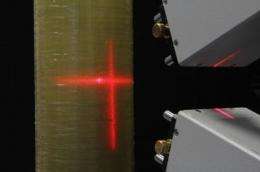Seeing inside the nose of an aircraft

Radio signals reach pilots on board an aircraft through the "radar dome", the rounded nose of the aircraft. But if errors occur during the production of this "nose", - tiny foreign particles, drops of water or air bubbles - this can impede radio traffic. In the future, a non-destructive testing system will identify just such imperfections during production. Researchers will be presenting the new testing system at the Control trade fair, May 8-11 in Stuttgart.
The planned arrival time, the request to land or the landing direction – this is the kind of information pilots discuss via radio with ground staff in the control tower. The nose of the aircraft, the „radar dome", receives incoming radio signals and transmits radio signals sent by the pilot as well. It is made of a fiberglass composite. But if even tiniest imperfections arise during production – if, for instance, little foreign particles, drops of water or air bubbles become enclosed in the resin – over time they can cause fine cracks through which moisture can seep. This causes interference in radio traffic through the aircraft nose, introducing static into the signal.
As part of the Dotnac project, researchers at the Fraunhofer Institute for Physical Measurement Techniques IPM in Kaiserslautern are working with partners in industry and research to develop a new testing system: the system uses terahertz waves to completely scan the aircraft nose, which is several centimeters thick, and immediately identify any flaws. The frequency of terahertz waves falls between that of microwaves on the one hand and infrared light on the other. They are completely harmless to humans. The waves are generated in a rolling cabinet not unlike those found in many offices: it contains a microwave source and all electronics to control the system and to collect the data. A frequency mixer multiplies the frequency of the microwave radiation generated into the terahertz range. Researchers have connected the actual measurement module to this container by means of electrical wires. This module emits the terahertz waves toward the radar dome. The material reflects the radiation, and the detector integrated in this module analyzes the reflected terahertz radiation. If there are any air bubbles or little imperfections embedded in the material, they turn up in the reflected signal. The main challenge facing researchers was to find out which terahertz frequencies they would have to use to bombard the material to achieve the most effective results for the various imperfections. Higher frequencies create better resolution, while lower frequencies have less difficulty penetrating the material. The researchers select from a range of different frequencies depending on the errors the researchers are looking for in the case concerned. The scientists have already developed a prototype of the testing system. It will be presented at the Control trade fair, May 8-11, in Stuttgart (Hall 1, stand 1502). Around a year from now, the scanner will have advanced to the point that it will scan and analyze aircraft noses automatically. Thus far, simple scanners for level and rotations symmetrical objects are available.
Researchers have come up with another terahertz testing system as well, one that analyzes the thickness of layers – such as are found on aircraft and cars. "Our terahertz measuring system is one of the few robust enough for industrial use," according to Dr. Joachim Jonuscheit, deputy head of department at Fraunhofer IPM. Just like the system that checks aircraft noses, this one also consists of a rolling cabinet along with a transmitter and a receiver connected to the container by cables five meters long. This system works with very short terahertz pulses. Each pulse is partially reflected off of the interfaces of the layers: the surface of the first layer, the interface between layer one and two, and so on. The deeper the layer reflecting the pulses, the longer the pulses take to return to the detector. Using the time each pulse takes to make its way back to the detector, built-in software automatically calculates the thickness of the various layers.
The system's great advantage is its robustness. But how did researchers accomplish this? "First of all, we no longer shoot the laser that excites the system by open beam as typically used in terahertz systems; instead, we feed it through optical fibers. And secondly, we have fixed and arranged the optical elements to make them mechanically robust. We have also improved the manufacturing processes for the semiconductor components – the transmitters and detectors – to make the individual elements more resistant," Jonuscheit explains. At the Control trade fair, the researchers will demonstrate live measurements on multi-layered plastic films of varying thicknesses.
Provided by Fraunhofer-Gesellschaft

















